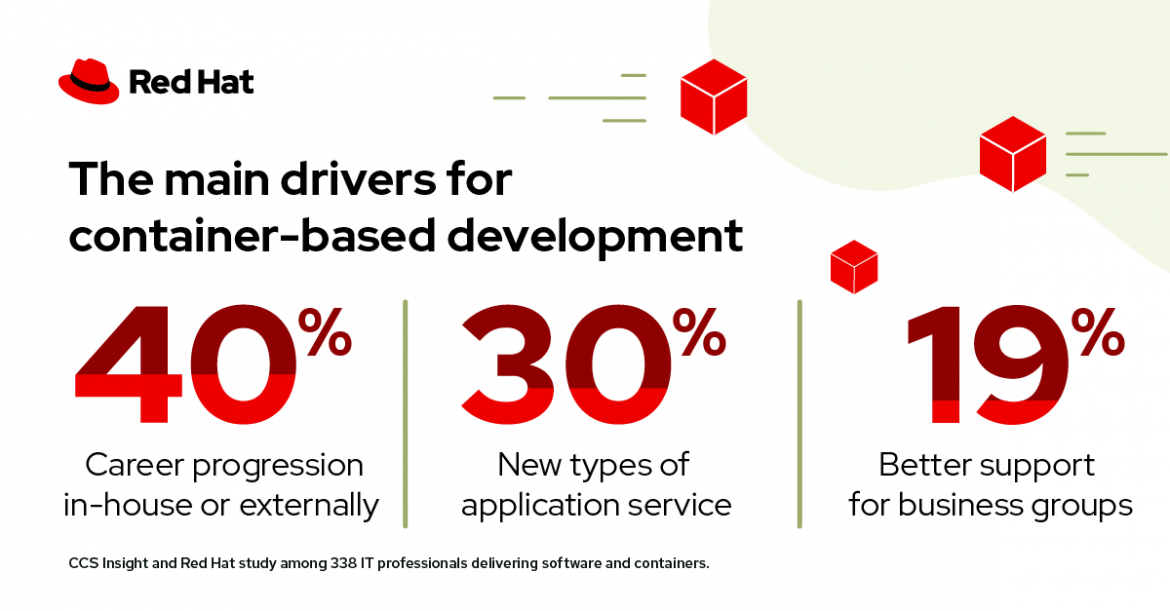By Guest Author: Markus Eisele, Developer Adoption Program Lead in EMEA @ Red Hat
When Linux containers first emerged as an architectural concept for building and packaging applications, they opened the door to a whole new world for developers. The Kubernetes container orchestration platform quickly followed, giving organizations a way to more fully harness the power of containers by answering the need for managing container environments at scale. The result was a wholesale shift in how we think about the cloud.
To better understand the impact of containers and Kubernetes on developers today, we commissioned CCS Insight to explore the current state of container use — including the benefits, challenges, adoption and use cases of container technology—in organizations across Europe, the Middle East and Africa (EMEA). Today, we are pleased to share the results of these findings, based on feedback from hundreds of IT professionals in both technical- and business-facing roles who are involved in architecting, developing, deploying and managing software application code and services.
First, let’s set some context. Applications are getting more complex, and the demand to develop faster is ever-increasing. To better respond to today’s fast-paced, software-driven markets, organizations are changing the way they design, build and deploy applications, using cloud-native architectures based on containers—and this trend is expected to continue. According to industry analyst firm IDC, "By 2024, 75% of enterprises will prioritize infrastructure agility and operational efficiency, leading to a 5x increase in the adoption of cloud-native architectures for core business applications." This mirrors findings from our own study, in which cloud adoption (33%), scalable operations (30%) and improved productivity (29%) were among the top business benefits identified by respondents for using containers.
In light of this, it comes as no surprise that container-based development was noted as a high or important priority for 91% of respondents who are directly involved in application development and deployment through producing software application code or deploying application services. Among those rating container-based development as a high or important priority, thirty percent (30%) are motivated by the need to deliver new types of application services, while another 19% are turning to containers as a way to better support business groups in their organization. Given the broad use of containers throughout the IT industry, the technology also presents a professional growth opportunity for developers. Forty percent (40%) of these respondents pointed to career progression as a key driver for using them.

Partners are key
As the use of containers increases, so does the need for capabilities that support this growth. Platforms like Kubernetes that help orchestrate, automate and manage containers are critical for making the technology tractable in an enterprise environment. Respondents recognize this, with 61% acknowledging that they need container orchestration services; however, 19% of these respondents view it as being too complex to implement themselves. Consequently, more than half of all respondents expect container development in their organization will be conducted by a third-party service provider, either wholly (24%) or through a combination of service provider and in-house resources (32%).
Among respondents who are decision-makers or influencing the choice of container-based programming technologies, usability of tooling services (37%) and reputation and trust (44%) are the two leading requirements governing their choice of vendor to support their container-based application goals. Those that get the balance right between developing and engaging internal talent and working with external partners should be well-positioned to meet the growing cloud opportunity. According to IDC, "The ecosystem of tech companies helping customers migrate to cloud environments, create new innovations in the cloud, and manage their expanding cloud environments will enable enterprises to meet their accelerated schedules for moving to cloud."

Overall, container adoption is high among organizations represented in the survey, with 71% of respondents indicating that they are actively using the technology in some form, whether in widespread production (22%), limited production (26%) or in pilot projects (23%).
Containers are a top software priority
There is a strong appetite for containers that reflects a drive to modernise as well as improve the quality, performance and security of applications. Forty-six percent of respondents who are involved in producing software application code or deploying application services placed container-based applications as a top software development priority over the next 12 months. This is followed by improving quality, performance and security of applications (43%), strengthening CI and CD processes (32%), improving portability (29%) and migrating to cloud-based operations (27%).

Hybrid Cloud is a key driver to container adoption
Thirty-four percent (34%) of technical respondents who are directly involved in producing software application code or deploying application services and have direct container programming and development experience named support for hybrid IT operations as a key development and operational benefit of using containers. Hybrid cloud is the ongoing reality within organisations at multiple levels – infrastructure, tools and applications – necessitating a multifaceted open platform and support services capable of mitigating the complexity drain on productivity and velocity. The survey findings show that respondents see containers providing both technical and business benefits that validate their role in enabling application portability and a consistent deployment model for hybrid IT operations. Out of the 524 respondents who were served on the issue, 43% said the predominant types of container-based applications being developed and deployed within organisations are those that simplify integration and consistency for internal systems and components.
The overarching trend that we see coming out of this survey is that containers are more than just a ‘nice-to-have’ technology. They are an important element to sustainability and success for today’s organizations. And with the increased realisation of their business benefits, alongside their IT capabilities, the race is now on to leverage containers to enable greater competitive advantage. Our data shows a lot of additional insights and we invite you to download the full report here or an infographic breaking down the key findings of the report.
Methodology
Red Hat commissioned CCS Insight to poll IT professionals with a mix of both technical- and business-facing roles from organizations across Europe, the Middle East and Africa (EMEA). The survey was completed in March 2021, and was carried out online and by telephone. Five hundred and seventy-four (574) individuals participated in the study. Respondents were not required to answer every question.









